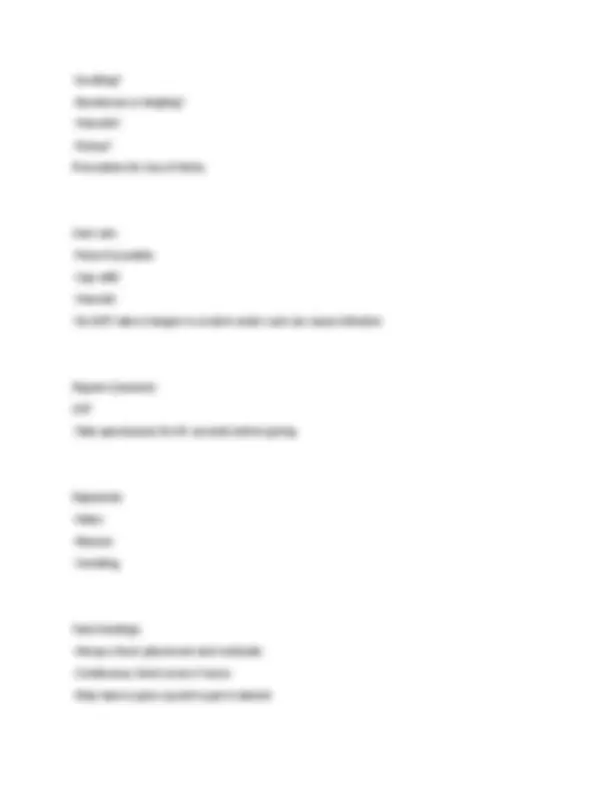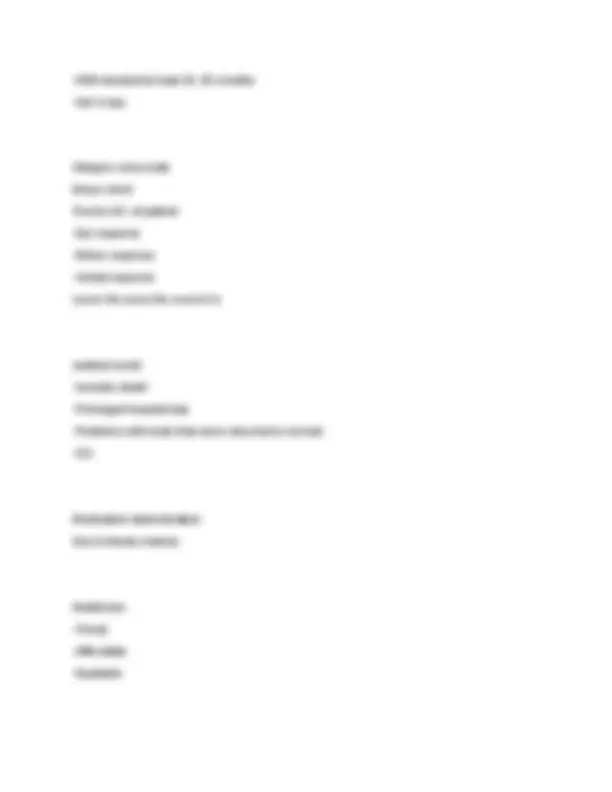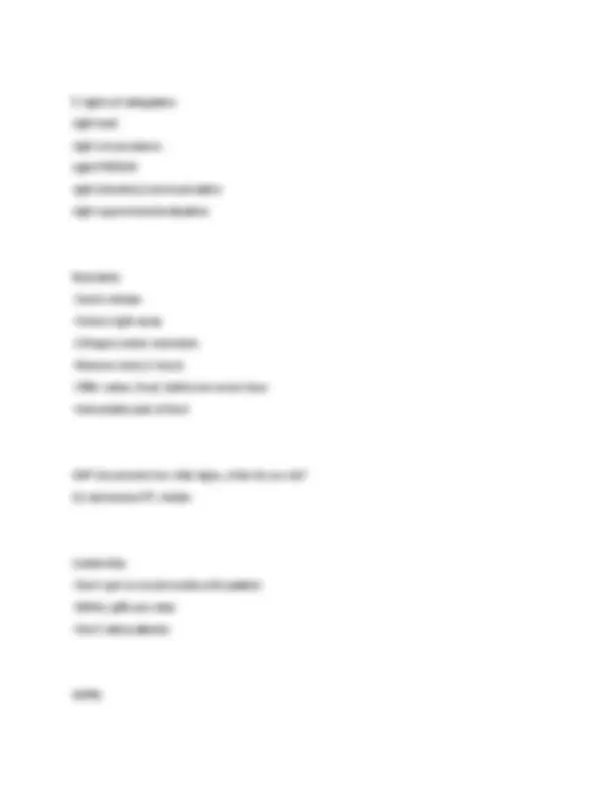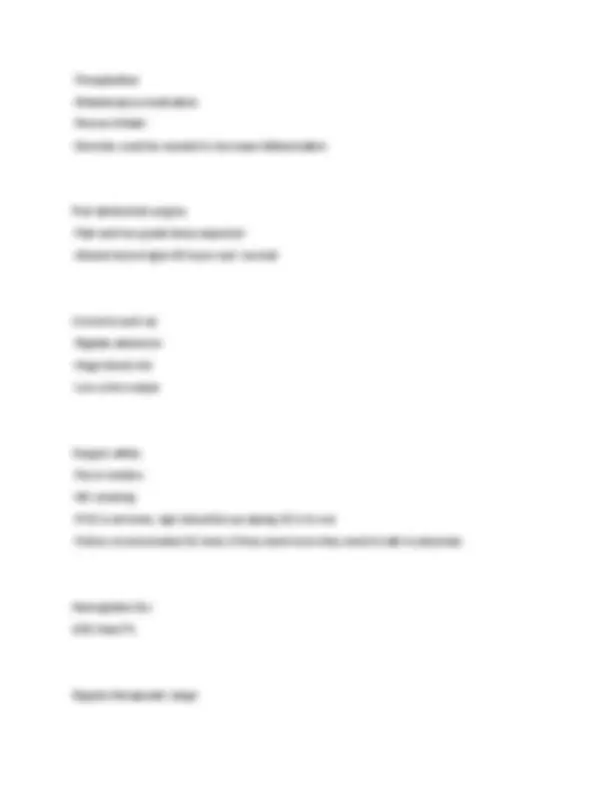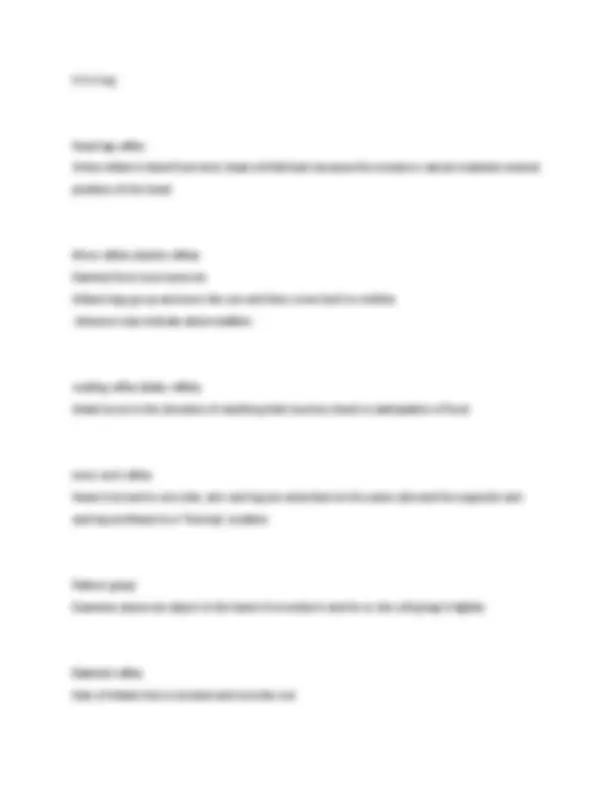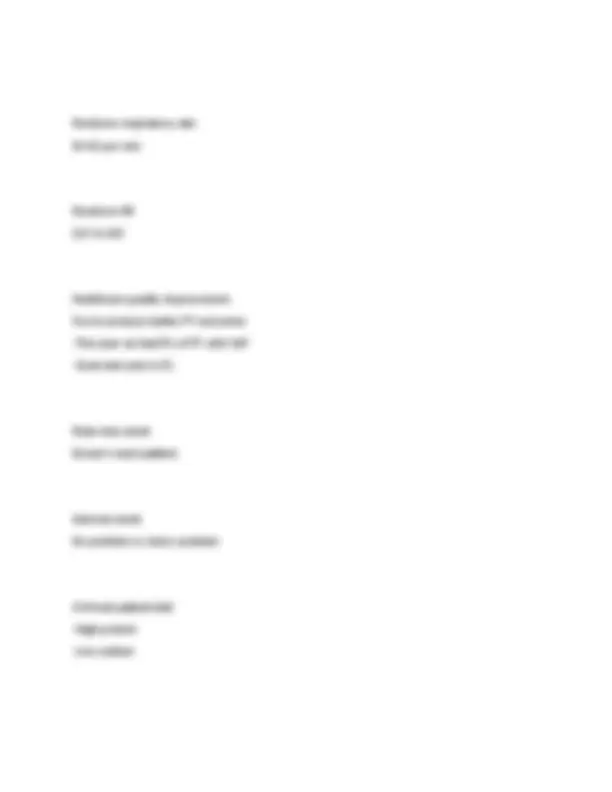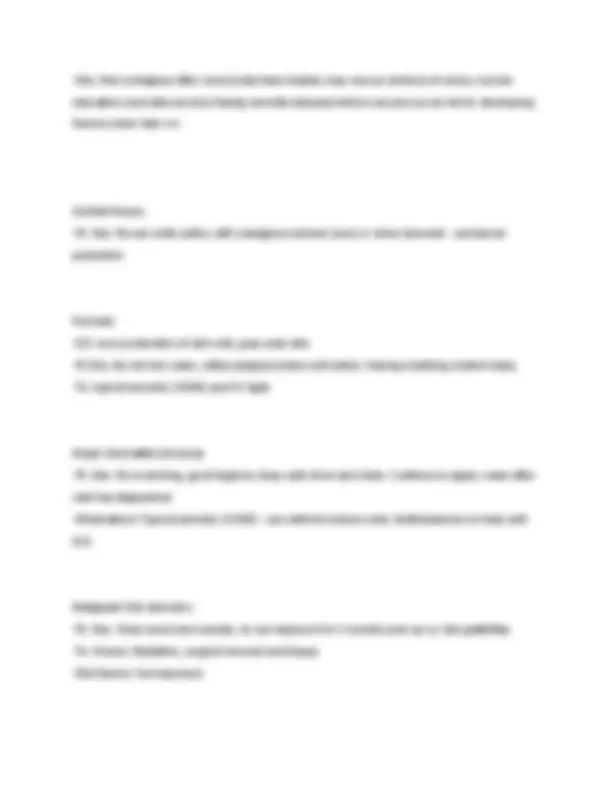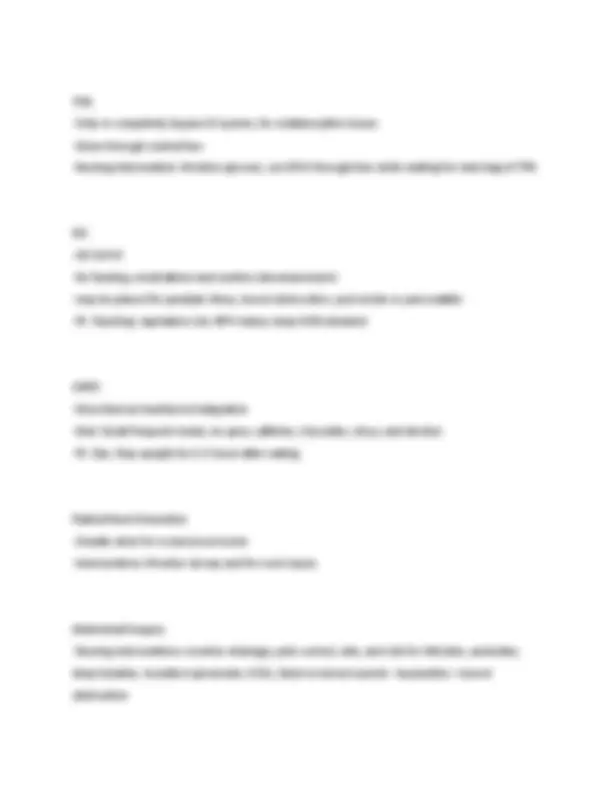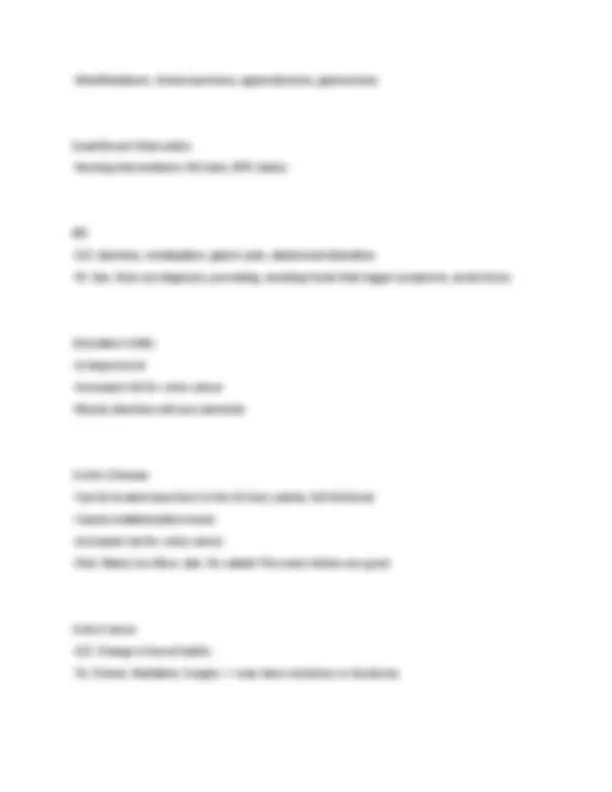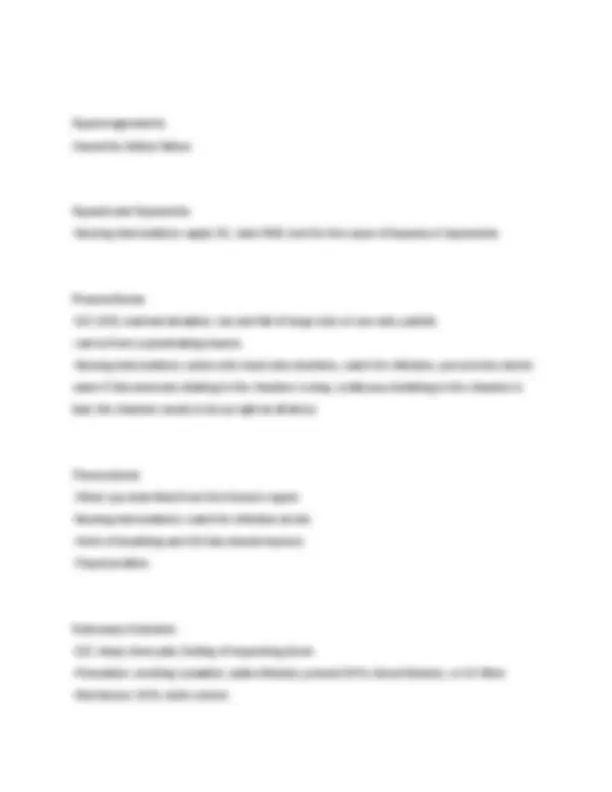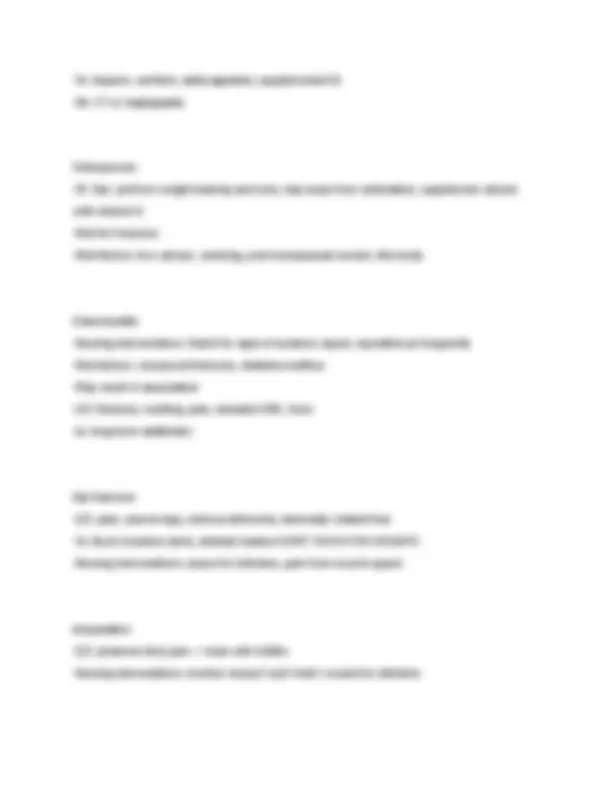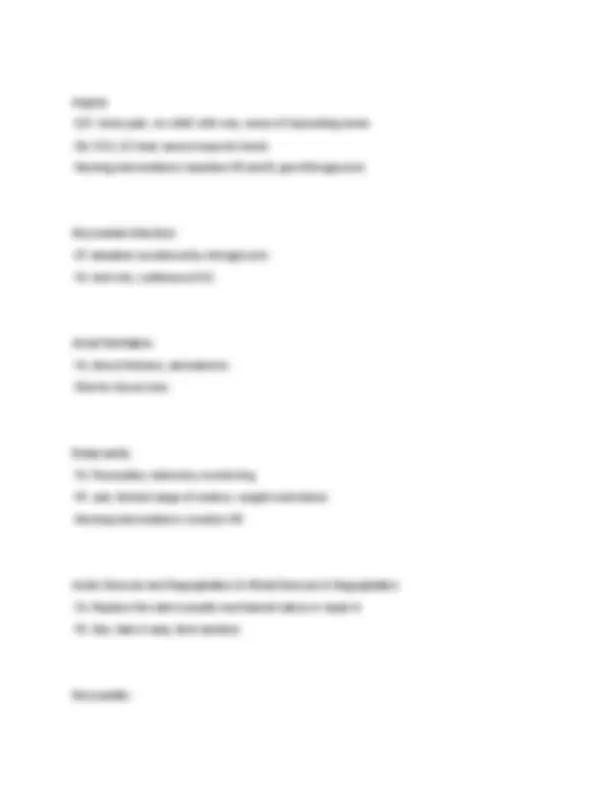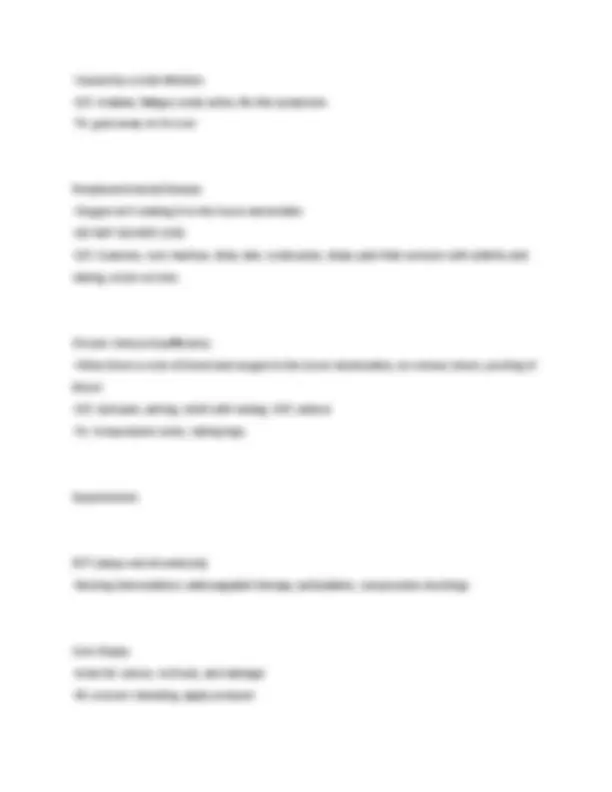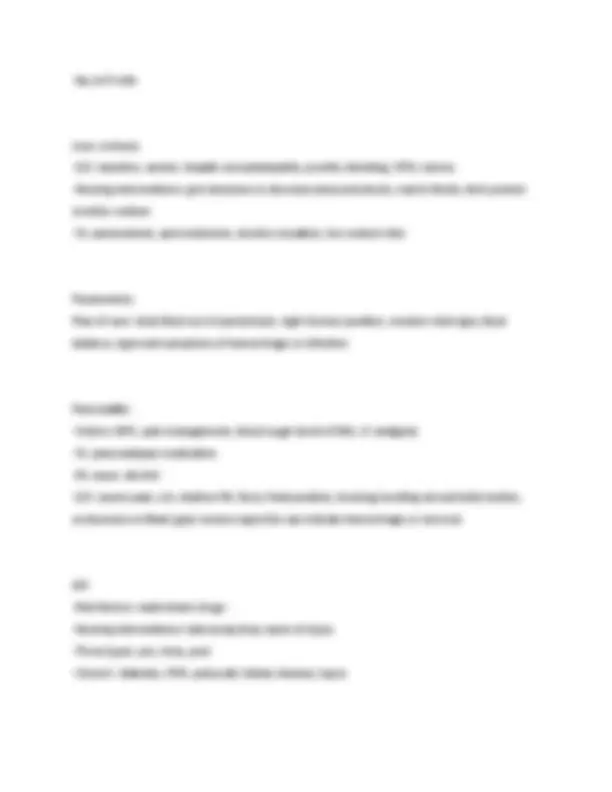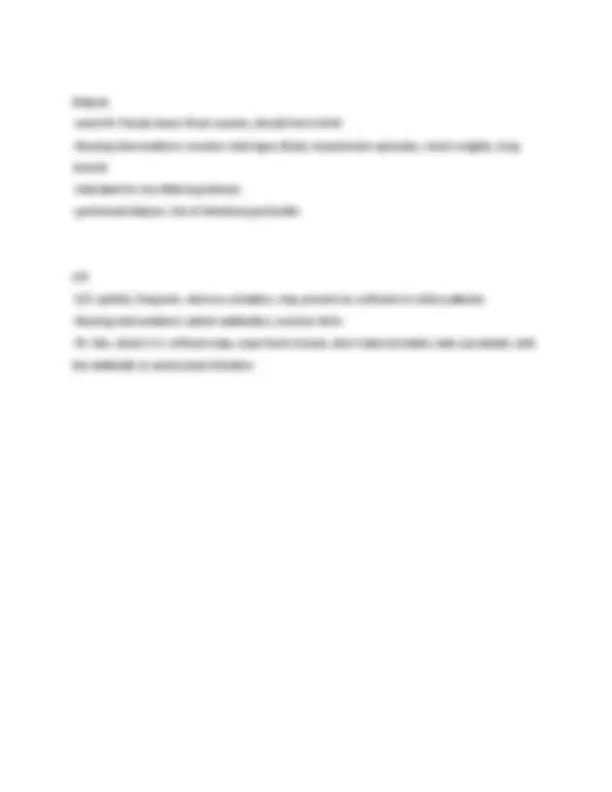Download NUR 195 ACTUAL FINAL EXAM 2025 TERM 4 – COMPLETE 50 QUESTIONS (ANSWERED) GRADED A and more Exams Nursing in PDF only on Docsity!
NUR 195 ACTUAL FINAL EXAM 2025 TERM 4 – COMPLETE 50
QUESTIONS (ANSWERED) GRADED A
PT has chest pain
- If BP is okay, you can give nitro and morphine- if its push RN must give
- Get EKG
- Give 4 chewable aspirin
- Have crash cart at bedside Nitro forms
- Sublingual
- IV drip
- PO
- PO spray Nitro use
- Angia
- High BP
- Suspected MI
- Will lower BP Sildenafil (Viagra) Do not give with nitro
Cardiac modifiable risk factors
- Hypertension
- Diabetes
- Smoking
- Stress
- High cholesterol
- Obesity CPR (cardiopulmonary resuscitation)
- Back board under PT
- Press sternum- NOT over sifoid process
- Know code status
- Start with compressions then airway, then breathing (CAB)
- 100 compressions/minute
- Breath every 8-10 seconds Cardiac strips, you're at the nurses station and you see. What do you do?
- Go to the PT to see if its real milia in a newborn Tiny, white, cystic lesions. Usually resolve w/in a few weeks NORMAL Circulation checks
- Hands, arms, legs
- HOB elevated at least 30, 45 is better
- Get X-rays Glasgow coma scale Neuro check Checks LOC of patient
- Eye response
- Motor response
- Verbal response Lower the score the worse it is sentinel event
- Includes death
- Prolonged hospital stay
- Problems with body that never returned to normal
- ICU Medication administration Give in timely manner Healthcare
- Timely
- Affordable
- Equitable
5 rights of delegation right task right circumstance right PERSON right direction/communication right supervision/evaluation Restraints
- Quick release
- Orders right away
- 2 fingers under restraints
- Remove every 2 hours
- Offer water, food, bathroom every hour
- Immovable part of bed UAP documents low vital signs, what do you do? Go and assess PT, retake Leadership
- Don't get on social media with patient
- SMALL gifts are okay
- Don't date patients HIPPA
- Braden scale- skin breakdown
- Epworth sleep scale
- SPICES- Remember problems elderly have
- Clinical judgement- way nurses think and come up with solutions to pt problem Nonpharmacologic interventions
- Back rubs
- Music
- Dim lights
- Photo therapy Hypocalcemia S/S
- Chovastek
- Trousseaus
- Seizures
- Tetany What does hospital do in sentinel events/leap frog group
- Talk to family that was affected and apologies
- Record to designated agencies- joint commission
- Reports that need filled out including Root-cause analysis
- PT is not charged Asthma
- Peak-flow meter
- Theophylline
- Maintenance medication
- Rescue inhaler
- Steroids could be needed to decrease inflammation Post abdominal surgery
- Pain and low grade temp expected
- Absent bowel signs 48 hours out= normal Concerns post op
- Rigidity abdomen
- Huge blood clot
- Low urine output Oxygen safety
- Put in holders
- NO smoking
- If O2 is at home, sign should be up saying O2 is in use
- Follow recommended O2 level, if they need more they need to talk to physician Hemoglobin A1c LESS than 7% Digoxin therapeutic range
Newborn respiratory rate 30 - 60 per min Newborn HR 110 to 160 Healthcare quality improvement Trys to produce better PT outcomes
- This year we had 5% of PT with VAP
- Goal next year is 2% Near miss event Doesn't reach patient Adverse event No problem or minor problem Cirrhosis patient diet
- High protein
- Low sodium
Diet for an acute problem with cirrhosis Low protein diet PT education with cirrhosis Stop drinking Reduce sodium intake Situational Leadership Adaptation of leadership style to fit the situation autocratic leadership A form of leadership in which the leader makes decisions on his or her own and then announces those decisions to the group. Lasseiz-faire leadership "lazy"
- Stands at a distance
- Gives employees freedom to make decisions
- Doesnt like to make decisions
- Little communication with employees about their work Democratic leadership involves all members in decision making
- Edu: Not contagious after sores/scabs have healed, may reoccur at times of stress, vaccine education (varicella vaccine) Having varicella (disease) before can put you at risk for developing herpes zoster later on. Genital Herpes
- Pt. Edu: No sex while active, still contagious without sores or when dormant - use barrier protection. Psoriasis
- S/S: over production of skin cells, gray scaly skin.
- Pt Edu: No hot hot water, soften plaques/scales with lotion. Having a bathing routine helps.
- Tx: topical steroids (-SONE) and UV light. Atopic Dermatitis (Eczema)
- Pt. Edu: No scratching, good hygiene, keep nails short and clean. Continue to apply cream after rash has diappeared.
- Medications: Topical steroids (-SONE) - use until the lesions clear. Antihistamines to help with itch. Malignant Skin disorders
- Pt. Edu: Wear sunscreen outside, no sun exposure for 3 months post op w/ skin graft/flap
- Tx: Chemo, Radiation, surgical removal and biopsy
- Risk factors: Sun exposure.
TPN
- Only to completely bypass GI system, for malabsorptive issues
- Given through central line
- Nursing intervention: Monitor glucose, run D5W through line while waiting for next bag of TPN NG
- GO SLOW
- for feeding, medications and suction (decompression)
- may be placed for paralytic illeus, bowel obstruction, post stroke or pancreatitis
- Pt. Teaching: aspiration risk, NPO status, keep HOB elevated GERD
- Described as heartburn/indigestion
- Diet: Small frequent meals, no spicy, caffeine, chocolate, citrus, and alcohol.
- Pt. Edu: Stay upright for 2-3 hours after eating Radical Neck Dissection
- Usually done for a cancerous tumor
- Interventions: Monitor airway and for neck issues Abdominal Surgery
- Nursing interventions: monitor drainage, pain control, diet, and risk for infection, ambulate, deep breathe, incentive spirometer, SCDs, listen to bowel sounds - hypoactive = bowel obstruction
Post Op Colectomy
- Stoma should be pink/red and moist
- Ileostomy there should be liquid stools
- Colostomy there should be semi-formed stools
- There won't be a lot of drainage post op because of NPO status before surgery, may take 24- 48 hrs to see any drainage. Hyponatremia S/S and Causes:
- diarrhea/vomiting
- diuretics
- adrenal insufficiency
- SIADH
- TPN (dextrose and water) Hypernatremia S/S and Causes:
- Watery stool
- heat stroke Hypocalcemia S/S and Causes:
- pancreatitis
- kidney failure
- amnioglycosides
Hypercalcemia S/S and Causes:
- Hyperparathyroidism
- Malignant tumors
- Immobilization r/t fractures
- Thiazide diuretics Hypokalemia S/S and Causes:
- Alkalosis
- Vomiting
- Gastric suction
- Anorexia
- Furosemide
- Steroids Hyperkalemia Caused by kidney failure Hypomagnesemia S/S and Causes:
- alcohol abuse
- diarrhea
- gentamicin
- Tx: heparin, warfarin, anticoagulants, supplemental O
- Dx: CT w/ angiography Osteoporosis
- Pt. Edu: perform weight bearing exercises, stay away from carbination, supplement calcium with vitamin D.
- Risk for fractures
- Risk factors: low calcium, smoking, post-menopausal women, thin body. Osteomyelitis
- Nursing interventions: Watch for signs of systemic sepsis, reposition pt frequently
- Risk factors: cmopound fractures, diabetes mellitus
- May result in amputation
- S/S: Redness, swelling, pain, elevated WBC, fever
- tx: long-term antibiotics Hip fractures
- S/S: pain, uneven legs, obvious deformity, externally rotated foot.
- Tx: Buck's traction (skin), skeletal traction DON'T TOUCH THE WEIGHTS
- Nursing interventions: assess for infection, pain from muscle spasm Amputation
- S/S: phantom limb pain - > treat with GABAs
- Nursing interventions: monitor stump? nub? limb? wound for infection.
Angina
- S/S: chest pain, no relief with rest, sense of impending doom
- Dx: ECG, 12-lead, assess troponin levels
- Nursing interventions: baseline HR and B, give Nitroglycerin Myocardial infarction
- ST elevation unrelieved by nitroglycerin
- Tx: bed rest, continuous ECG Atrial Fibrillation
- Tx: blood thinners, amiodarone
- Risk for blood clots Bradycardia
- Tx: Pacemaker, telemetry monitoring
- Pt. edu: limited range of motion, weight restrictions
- Nursing interventions: monitor HR Aortic Stenosis and Regurgitation & Mitral Stenosis & Regurgitation
- Tx: Replace the valve (usually mechanical valve) or repair it
- Pt. Edu: take it easy, limit exertion Myocarditis

